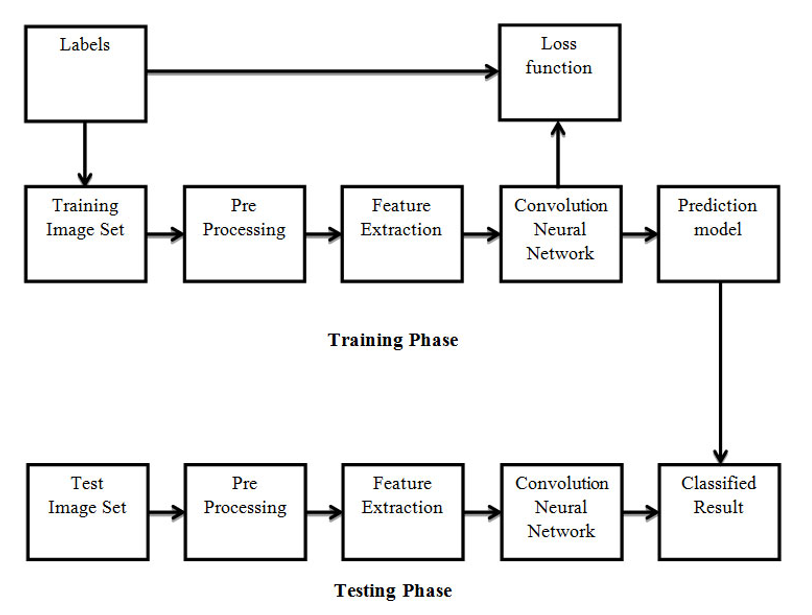An Automated Abnormality Diagnosis and Classi?cation in Brain MRI using Deep Learning
Main Article Content
Abstract
A technique for recognising and labeling malignant brain tissues according to the types of tumours present is known as tumour classification. Magnetic resonance imaging (MRI) can be used in clinical settings to both diagnose and treat gliomas. For clinical diagnosis and treatment planning, the ability to correctly diagnose a brain tumour from MRI images is essential. Manual classification, however, is not feasible in a timely manner due to the enormous volume of data produced by MRI. For classification and segmentation, it is required to employ automated algorithms. However, the numerous spatial and anatomical differences present in brain tumours make MRI image segmentation challenging. We have created a unique CNN architecture for classifying three different types of brain cancers. The new network was demonstrated to be more straightforward than earlier networks using MRI images with contrast-enhanced T1 pictures. Two 10-fold cross-validation techniques, two datasets, and an evaluation of the network's performance were used. A piece of upgraded picture information is used to assess the transferability of the network as part of the subject-cross-validation process. When used for record-wise cross-validation, this method of tenfold cross-validation ground set has an accuracy rate of 92.65 percent. Radiologists who operate in the ground of medical diagnostics may find the newly proposed CNN architecture to be a helpful decision-support tool due to its new transferability capability and speedy execution..
Article Details
References
Murthy, M. Y. B., Koteswararao, A., & Babu, M. S. (2022). Adaptive fuzzy deformable fusion and optimized CNN with ensemble classification for automated brain tumor diagnosis. Biomedical engineering letters, 12(1), 37-58.
Gurunathan, A., & Krishnan, B. (2022). A Hybrid CNN-GLCM Classifier For Detection And Grade Classification Of Brain Tumor. Brain Imaging and Behavior, 1-18.
Ak, A., Topuz, V., & Midi, I. (2022). Motor imagery EEG signal classification using image processing technique over GoogLeNet deep learning algorithm for controlling the robot manipulator. Biomedical Signal Processing and Control, 72, 103295.
Khan, A. R., Khan, S., Harouni, M., Abbasi, R., Iqbal, S., & Mehmood, Z. (2021). Brain tumor segmentation using K?means clustering and deep learning with synthetic data augmentation for classification. Microscopy Research and Technique, 84(7), 1389-1399.
Bhuvaneswary, N., Lakshmi, A., Bhuvaneswari, E., Ahmed, P. J., & Vaishnavi, M. (2022, March). Multi Modal Image Fusion Technique For Detecting Brain Tumor. In 2022 6th International Conference on Computing Methodologies and Communication (ICCMC) (pp. 1364-1371). IEEE.
Singh, R., & Agarwal, B. B. (2022). Abnormality detection and classi?cation from brain MRI using machine learning. International Journal of Health Sciences, 6(S3), 9170–9180. https://doi.org/10.53730/ijhs.v6nS3.8242.
Amin, J., Sharif, M., Raza, M., & Yasmin, M. (2018). Detection of brain tumor based on features fusion and machine learning. Journal of Ambient Intelligence and Humanized Computing, 1-17.
Usman, K., & Rajpoot, K. (2017). Brain tumor classification from multi-modality MRI using wavelets and machine learning. Pattern Analysis and Applications, 20(3), 871-881.
Pereira, S., Meier, R., Alves, V., Reyes, M., & Silva, C. A. (2018). Automatic brain tumor grading from MRI data using convolutional neural networks and quality assessment. In Understanding and interpreting machine learning in medical image computing applications (pp. 106-114). Springer, Cham.
Farhi, L., Zia, R., & Ali, Z. A. (2018). 5 Performance Analysis of Machine Learning Classifiers for Brain Tumor MR Images. Sir Syed University Research Journal of Engineering & Technology, 8(1), 6-6.
Vijh, S., Sharma, S., & Gaurav, P. (2020). Brain tumor segmentation using OTSU embedded adaptive particle swarm optimization method and convolutional neural network. In Data visualization and knowledge engineering (pp. 171-194). springer, Cham.
Mohsen, H., El-Dahshan, E. S. A., El-Horbaty, E. S. M., & Salem, A. B. M. (2018). Classification using deep learning neural networks for brain tumors. Future Computing and Informatics Journal, 3(1), 68-71.
Veeraraghavan, A., Roy-Chowdhury, A. K., & Chellappa, R. (2005). Matching shape sequences in video with applications in human movement analysis. IEEE Transactions on Pattern Analysis and Machine Intelligence, 27(12), 1896-1909.
Litjens, G., Kooi, T., Bejnordi, B. E., Setio, A. A. A., Ciompi, F., Ghafoorian, M., ... & Sánchez, C. I. (2017). A survey on deep learning in medical image analysis. Medical image analysis, 42, 60-88.
Akkus, Z., Galimzianova, A., Hoogi, A., Rubin, D. L., & Erickson, B. J. (2017). Deep learning for brain MRI segmentation: state of the art and future directions. Journal of digital imaging, 30(4), 449-459.
Cheng, J., Huang, W., Cao, S., Yang, R., Yang, W., Yun, Z., ... & Feng, Q. (2015). Enhanced performance of brain tumor classification via tumor region augmentation and partition. PloS one, 10(10), e0140381.
Ma, X., Liu, W., Tao, D., & Zhou, Y. (2019). Ensemble p-laplacian regularization for scene image recognition. Cognitive Computation, 11(6), 841-854.
Ramirez-Quintana, J. A., Madrid-Herrera, L., Chacon-Murguia, M. I., & Corral-Martinez, L. F. (2021). Brain-computer interface system based on p300 processing with convolutional neural network, novel speller, and low number of electrodes. Cognitive Computation, 13(1), 108-124.
Roy, Y., Banville, H., Albuquerque, I., Gramfort, A., Falk, T. H., & Faubert, J. (2019). Deep learning-based electroencephalography analysis: a systematic review. Journal of neural engineering, 16(5), 051001.
Jiang, X., Gu, X., Xu, K., Ren, H., & Chen, W. (2019). Independent decision path fusion for bimodal asynchronous brain–computer interface to discriminate multiclass mental states. IEEE Access, 7, 165303-165317.
Mohanty, R., Sinha, A. M., Remsik, A. B., Dodd, K. C., Young, B. M., Jacobson, T., ... & Prabhakaran, V. (2018). Machine learning classification to identify the stage of brain-computer interface therapy for stroke rehabilitation using functional connectivity. Frontiers in neuroscience, 12, 353.
Bablani, A., Edla, D. R., Tripathi, D., & Cheruku, R. (2019). Survey on brain-computer interface: An emerging computational intelligence paradigm. ACM Computing Surveys (CSUR), 52(1), 1-32.
Chakladar, D. D., & Chakraborty, S. (2019). Feature extraction and classification in brain-computer interfacing: Future research issues and challenges. In Natural Computing for Unsupervised Learning (pp. 101-131). Springer, Cham.
Ieracitano, C., Mammone, N., Hussain, A., & Morabito, F. C. (2020). A novel multi-modal machine learning based approach for automatic classification of EEG recordings in dementia. Neural Networks, 123, 176-190.
Kantak, S. S., Stinear, J. W., Buch, E. R., & Cohen, L. G. (2012). Rewiring the brain: potential role of the premotor cortex in motor control, learning, and recovery of function following brain injury. Neurorehabilitation and neural repair, 26(3), 282-292.
Kasabov, N. K. (2014). NeuCube: A spiking neural network architecture for mapping, learning and understanding of spatio-temporal brain data. Neural Networks, 52, 62-76.
Kasabov NK (2019) Time-space, spiking neural networks and brain-inspired artificial intelligence. Springer, Berlin
Kingma DP, Ba J (2014) Adam: A method for stochastic optimization. arXiv preprint arXiv:1412.6980
Krizhevsky A, Sutskever I, Hinton GE (2012) Imagenet classification with deep convolutional neural networks. In: Advances in neural information processing systems, pp 1097–1105.
Chen X, Xie H (2020) A structural topic modeling-based bibliometric study of sentiment analysis literature. Cogn Comput 1–33
Sultan, H. H., Salem, N. M., & Al-Atabany, W. (2019). Multi-classification of brain tumor images using deep neural network. IEEE Access, 7, 69215-69225.
Roy, Y., Banville, H., Albuquerque, I., Gramfort, A., Falk, T. H., & Faubert, J. (2019). Deep learning-based electroencephalography analysis: a systematic review. Journal of neural engineering, 16(5), 051001.
Bi, X., & Wang, H. (2019). Early Alzheimer’s disease diagnosis based on EEG spectral images using deep learning. Neural Networks, 114, 119-135.
Ullah, A., Anwar, S. M., Bilal, M., & Mehmood, R. M. (2020). Classification of arrhythmia by using deep learning with 2-D ECG spectral image representation. Remote Sensing, 12(10), 1685.
Srinivasan, K., & Nandhitha, N. M. (2019). Development of Deep Learning algorithms for Brain Tumor classification using GLCM and Wavelet Packets. Caribb. J. Sci, 53, 1222-1228.
Lakshmanaprabu, S. K., Mohanty, S. N., Shankar, K., Arunkumar, N., & Ramirez, G. (2019). Optimal deep learning model for classification of lung cancer on CT images. Future Generation Computer Systems, 92, 374-382.
Kumar, P. R., Sarkar, A., Mohanty, S. N., & Kumar, P. P. (2020, October). Segmentation of white blood cells using image segmentation algorithms. In 2020 5th International Conference on Computing, Communication and Security (ICCCS) (pp. 1-4). IEEE.
Singh, R., & Agarwal, B. B. (2022). A Hybrid Approach for Detection of Brain Tumor with Levy Flight Cuckoo Search. Webology, 19(1).
Lakshmanaprabu, S. K., Mohanty, S. N., Krishnamoorthy, S., Uthayakumar, J., & Shankar, K. (2019). Online clinical decision support system using optimal deep neural networks. Applied Soft Computing, 81, 105487.
Fernando, T., Denman, S., Ahmedt-Aristizabal, D., Sridharan, S., Laurens, K., Johnston, P., & Fookes, C. (2019). Neural memory plasticity for anomaly detection. arXiv preprint arXiv:1910.05448.
Rehman, A., Naz, S., Razzak, M. I., Akram, F., & Imran, M. (2020). A deep learning-based framework for automatic brain tumors classification using transfer learning. Circuits, Systems, and Signal Processing, 39(2), 757-775.
Tripathi, P. C., & Bag, S. (2020). Non-invasively grading of brain tumor through noise robust textural and intensity based features. In Computational intelligence in pattern recognition (pp. 531-539). Springer, Singapore.
Mangla, M., Sayyad, A., & Mohanty, S. N. (2021, May). An AI and Computer Vision-based Face Mask Recognition & Detection System. In 2021 2nd International Conference on Secure Cyber Computing and Communications (ICSCCC) (pp. 170-174). IEEE.
Kotia, J., Kotwal, A., & Bharti, R. (2019, October). Risk susceptibility of brain tumor classification to adversarial attacks. In International Conference on Man–Machine Interactions (pp. 181-187). Springer, Cham.
Moccia, S., Foti, S., Routray, A., Prudente, F., Perin, A., Sekula, R. F., ... & Riviere, C. N. (2018). Toward improving safety in neurosurgery with an active handheld instrument. Annals of biomedical engineering, 46(10), 1450-1464.
Singh, R., & Agarwal, B. B. (2022). An automated brain tumor classification in MR images using an enhanced convolutional neural network. International Journal of Information Technology, 1-10.
Ipp.cbica.upenn.edu. 2022. Penn Imaging – Home. [online] Available at: <https://ipp.cbica.upenn.edu/> [Accessed 12 March 2022].
Swati, Z. N. K., Zhao, Q., Kabir, M., Ali, F., Ali, Z., Ahmed, S., & Lu, J. (2019). Brain tumor classification for MR images using transfer learning and fine-tuning. Computerized Medical Imaging and Graphics, 75, 34-46.

